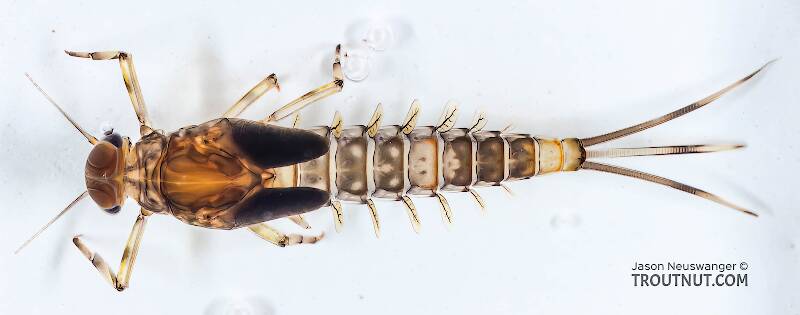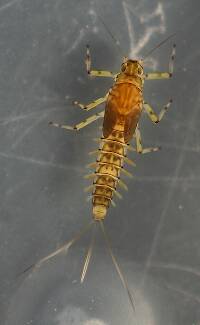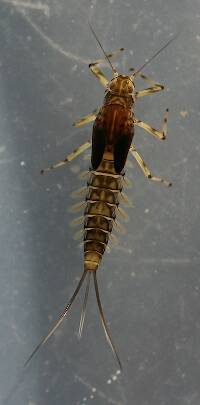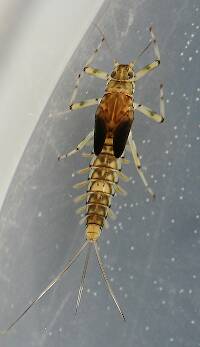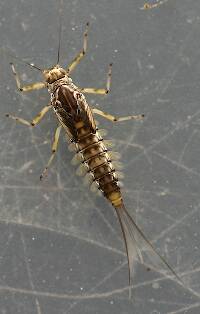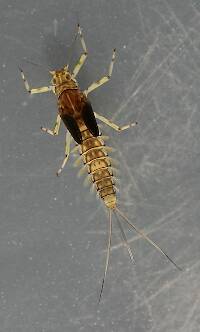
Hex Mayflies
Hexagenia limbata
The famous nocturnal Hex hatch of the Midwest (and a few other lucky locations) stirs to the surface mythically large brown trout that only touch streamers for the rest of the year.
Featured on the forum
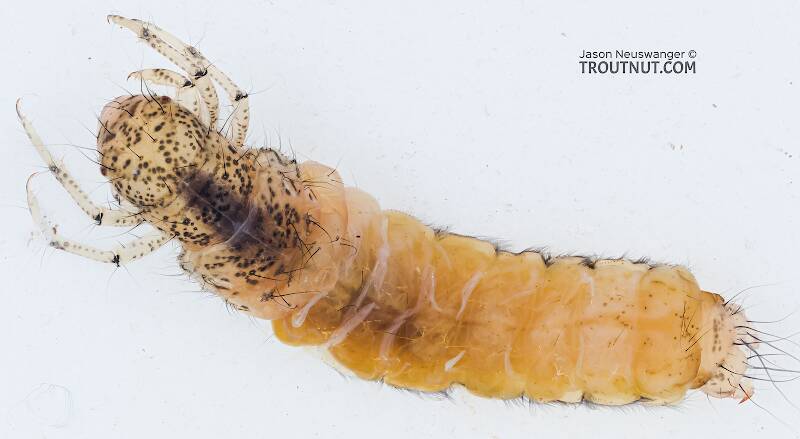
This is a striking caddis larva with an interesting color pattern on the head. Here are some characteristics I was able to see under the microscope, but could not easily expose for a picture:
- The prosternal horn is present.
- The mandible is clearly toothed, not formed into a uniform scraper blade.
- The seems to be only 2 major setae on the ventral edge of the hind femur.
- Chloride epithelia seem to be absent from the dorsal side of any abdominal segments.
Based on these characteristics and the ones more easily visible from the pictures, this seems to be Grammotaulius. The key's description of the case is spot-on: "Case cylindrical, made of longitudinally arranged sedge or similar leaves," as is the description of the markings on the head, "Dorsum of head light brownish yellow with numerous discrete, small, dark spots." The spot pattern on the head is a very good match to figure 19.312 of Merritt R.W., Cummins, K.W., and Berg, M.B. (2019). The species ID is based on Grammotaulius betteni being the only species of this genus known in Washington state.
- The prosternal horn is present.
- The mandible is clearly toothed, not formed into a uniform scraper blade.
- The seems to be only 2 major setae on the ventral edge of the hind femur.
- Chloride epithelia seem to be absent from the dorsal side of any abdominal segments.
Based on these characteristics and the ones more easily visible from the pictures, this seems to be Grammotaulius. The key's description of the case is spot-on: "Case cylindrical, made of longitudinally arranged sedge or similar leaves," as is the description of the markings on the head, "Dorsum of head light brownish yellow with numerous discrete, small, dark spots." The spot pattern on the head is a very good match to figure 19.312 of Merritt R.W., Cummins, K.W., and Berg, M.B. (2019). The species ID is based on Grammotaulius betteni being the only species of this genus known in Washington state.

Troutnut is a project started in 2003 by salmonid ecologist Jason "Troutnut" Neuswanger to help anglers and
fly tyers unabashedly embrace the entomological side of the sport. Learn more about Troutnut or
support the project for an enhanced experience here.
DarkDun
Posts: 16
Posts: 16
DarkDun on Jan 30, 2007January 30th, 2007, 5:24 pm EST
I see the grayish tint as more of a Salmon tint. I would tie up some variations and test them. I tie all my nymphs with a variegated coloration rather than a blend. This works on most flies and I try to match the tones to the segment(band)of the natural as you sugested. I have had much success with this approach.
Martinlf on Mar 19, 2008March 19th, 2008, 1:58 pm EDT
I'm back to wondering about baetis nymphs as I begin to tie them again. Does anyone have a favorite dubbing color for PA spring creeks? I'm going to try some spectrumized dubbings, and perhaps bands as DarkDun and I had been discussing. I think I'll stick with gold wire as the spaces between the segments appear lighter. I may use poly yarn for wingcases, or herl as Gary Borger recommends.
"He spread them a yard and a half. 'And every one that got away is this big.'"
--Fred Chappell
--Fred Chappell
LittleJ on Mar 20, 2008March 20th, 2008, 7:11 am EDT
mottled turkey quill. IT is already banded for you.
jeff
jeff
Martinlf on Mar 20, 2008March 20th, 2008, 11:27 am EDT
Jeff, do you tie it as a wrapped herl nymph, like a pheasant tail, or like a Skip's Nymph, with the herl as overback? I've also been thinking of dying some Golden Pheasant tail olive. I just dyed a batch of Pheasant Tail to try some Skip's Leadbelly Nymphs. or some Olive PT's.
"He spread them a yard and a half. 'And every one that got away is this big.'"
--Fred Chappell
--Fred Chappell
LittleJ on Mar 20, 2008March 20th, 2008, 1:56 pm EDT
I tie it as a wrapped herl nymph. I use it for several nymphs I just change the body shape.
jeff
jeff
Parker
Posts: 1
Posts: 1
Parker on Jul 18, 2009July 18th, 2009, 7:30 am EDT
How you "see" the colour on your computer monitor depends on may things and may have little to do with original colour.
For instance, yor monitor has to be profiled correctly. If you see salmon, you may have a red tint.
Also, the camera setting and profile matter, as well as any adjustments made to the photograph.
In addition the colour of light the insect was photographed in will make a difference.
For instance, yor monitor has to be profiled correctly. If you see salmon, you may have a red tint.
Also, the camera setting and profile matter, as well as any adjustments made to the photograph.
In addition the colour of light the insect was photographed in will make a difference.
Eat. Breathe. Fish.
Martinlf on Jul 18, 2009July 18th, 2009, 8:01 am EDT
Good point, Parker. Thanks.
"He spread them a yard and a half. 'And every one that got away is this big.'"
--Fred Chappell
--Fred Chappell
Lastchance on Jul 18, 2009July 18th, 2009, 12:35 pm EDT
When I tie my nymphs I always dunk them in a cup of water to see what the color looks like when wet. Water does change the color intensity.
Mottled turkey quill is a good baetis material.
Bruce
Mottled turkey quill is a good baetis material.
Bruce
Shawnny3 on Jul 18, 2009July 18th, 2009, 2:21 pm EDT
What Bruce says is especially important because different types of materials darken differently in water. My experience is that natural materials darken much more than synthetics do.
-Shawn
-Shawn
Jewelry-Quality Artistic Salmon Flies, by Shawn Davis
www.davisflydesigns.com
www.davisflydesigns.com
Quick Reply
Related Discussions
Topic
Replies
Last Reply


